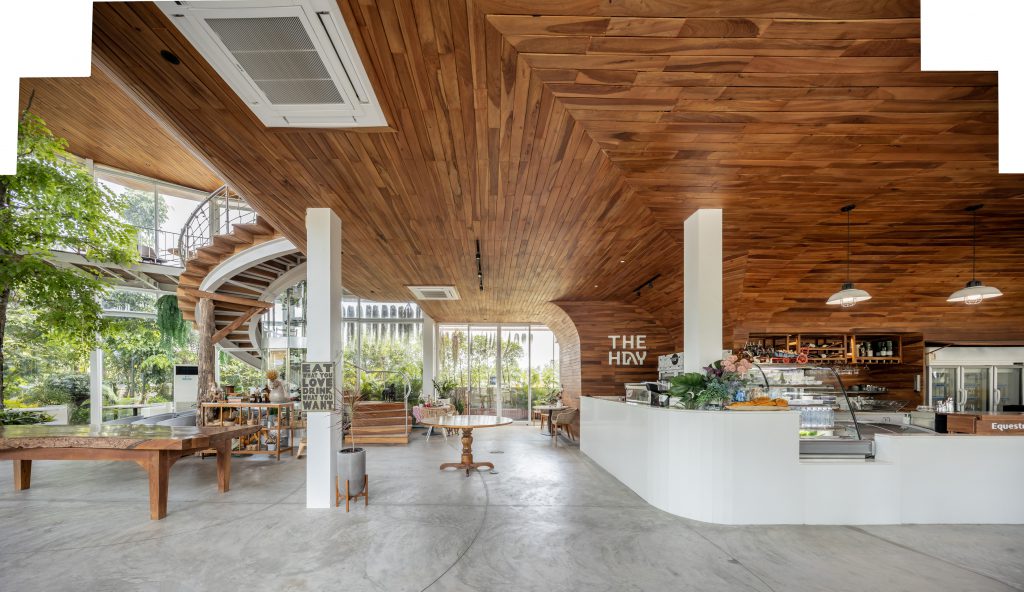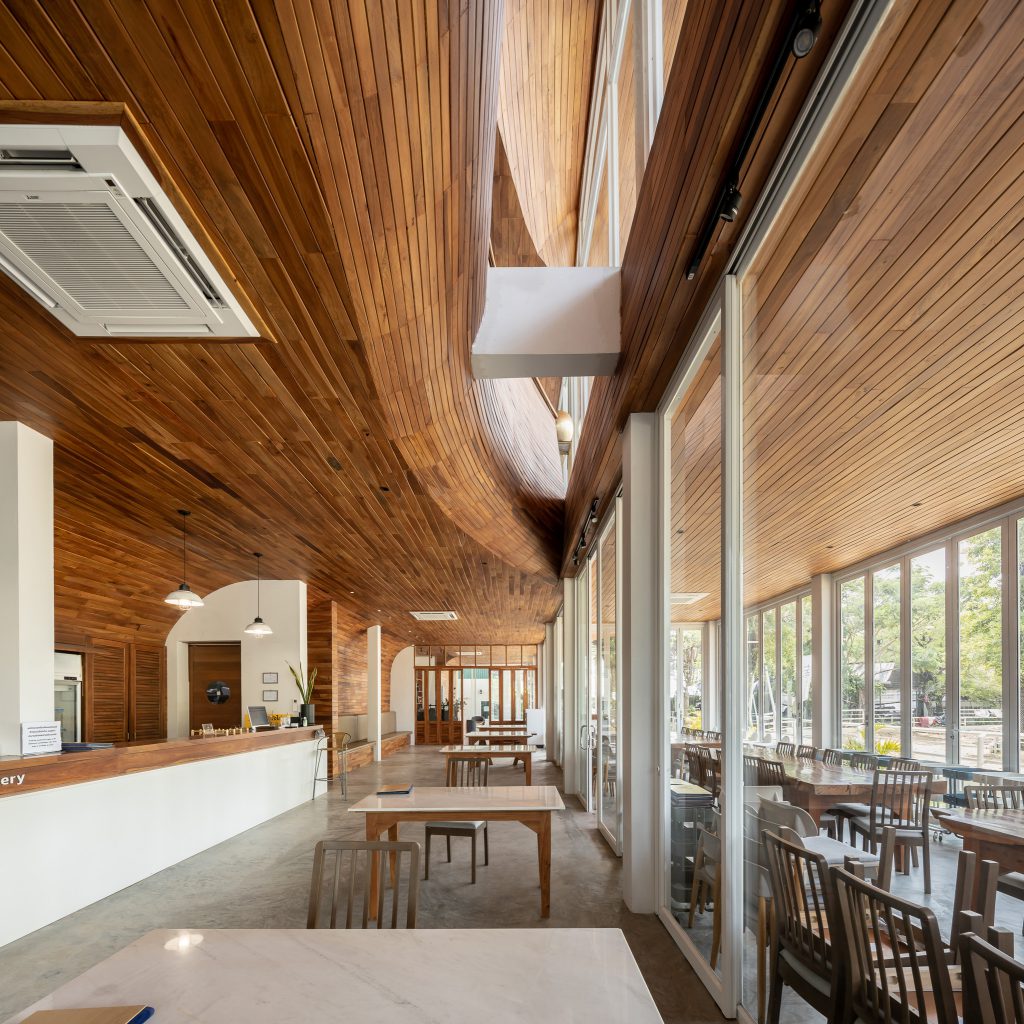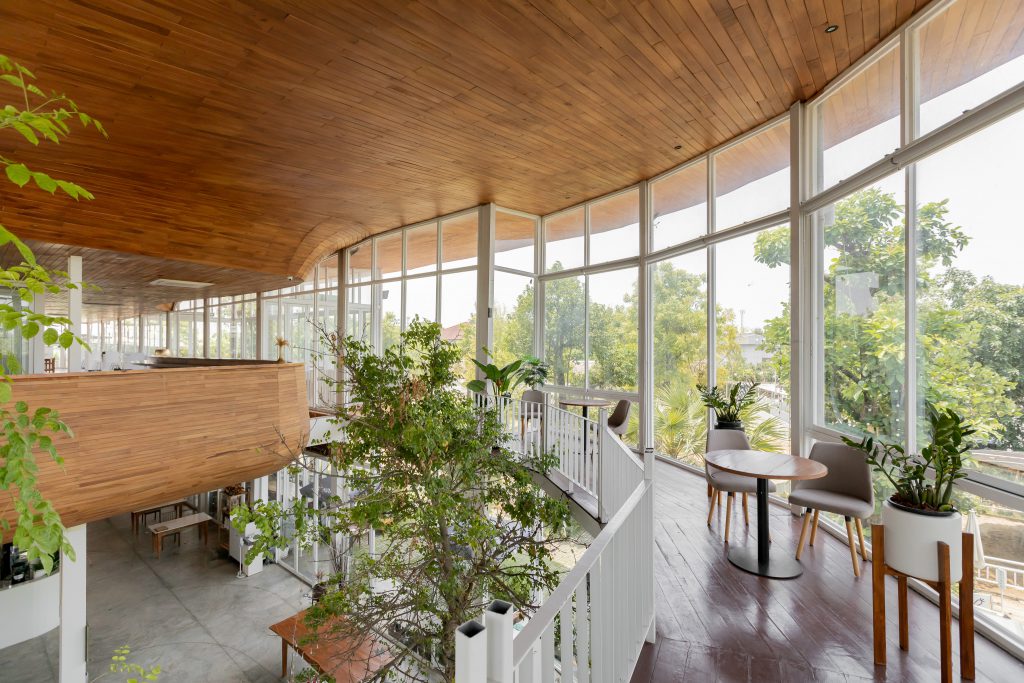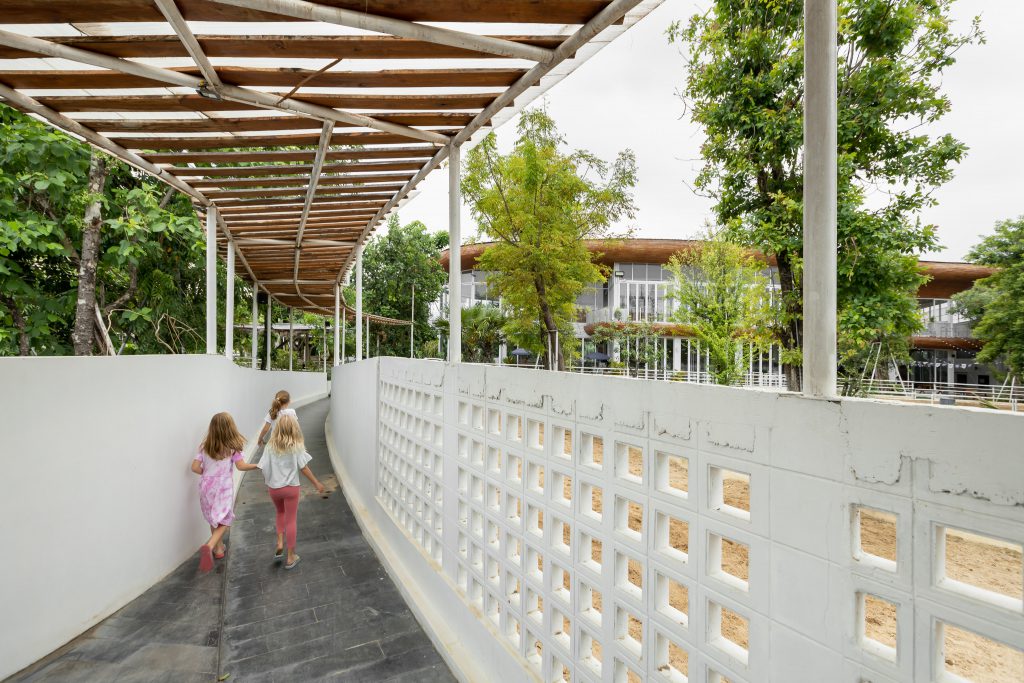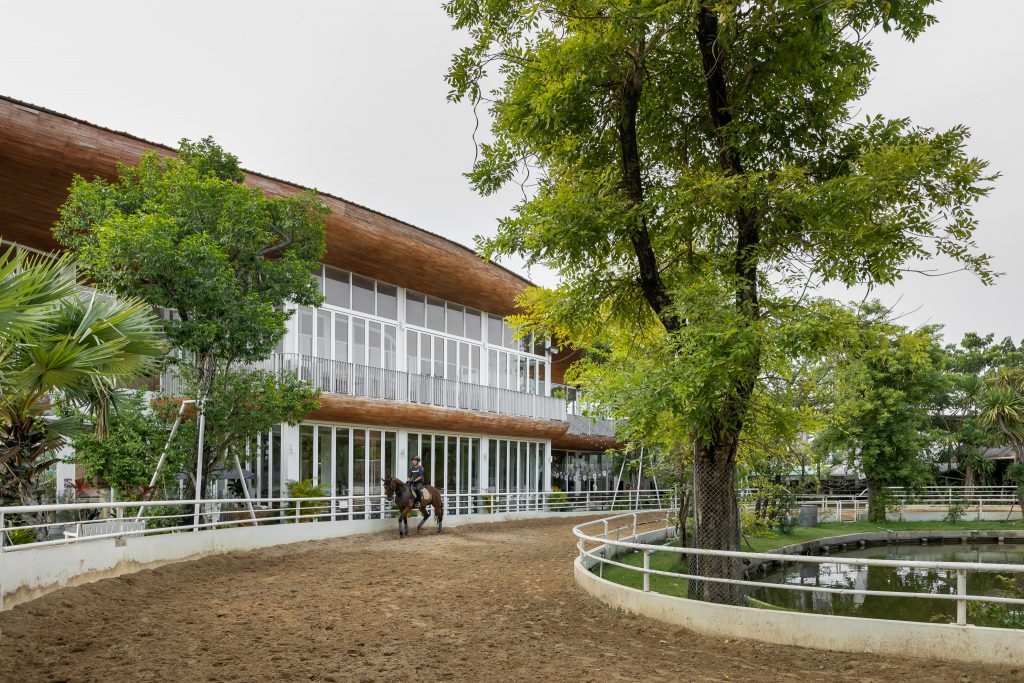Architectkidd has designed a horse-riding school in Bangbon that is friendly to both horses and people – an architectural design that could foster therapy programs, where horses participate in restoring the health of children and patients.
Text: Xaroj Phrawong
Photo: Ketsiree Wongwan
Download the online journal Issue 01 The ComfortZone Click here
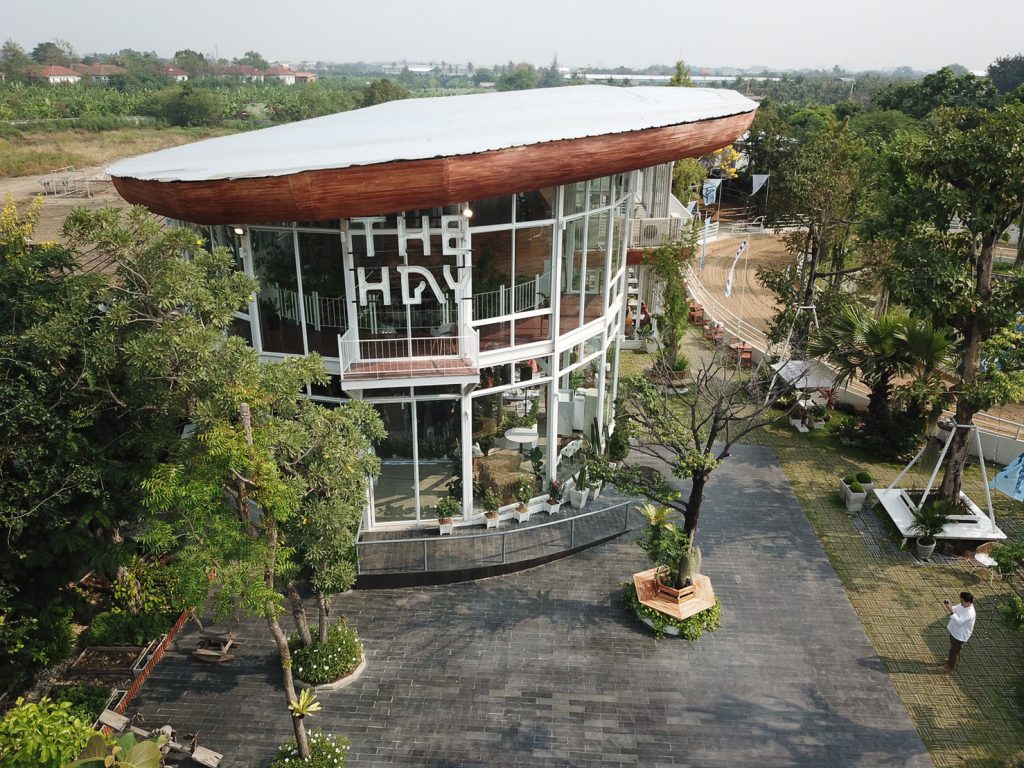
Photo: Ketsiree Wongwan
สถาปัตยกรรมเพื่อการบำบัดไม่จำเป็นต้องหมายถึงโรงพยาบาลเพียงอย่างเดียว แต่ในปัจจุบันยังสามารถ ครอบคลุมไปถึงสถาปัตยกรรมที่รองรับกิจกรรมใหม่อีกมากมาย หนึ่งในทางเลือกของการบำบัดที่ใช้สัตว์อย่างม้าเข้ามา ช่วยคือ Equineassisted therapy หรือการบำบัดด้วยม้าโดยมีกิจกรรมร่วมกับม้าชนิดต่างๆ หลายรูปแบบจุดประสงค์ก็เพื่อบำบัดมนุษย์ทั้งทางกายและจิตใจ วิธีการรักษาบำบัดเพื่อรักษาโรคเรื้อรังที่รักษาไม่หายนี้ถูกนำมาใช้ตั้งแต่ยุคกรีก ดังที่ปรากฏในงานเขียนของแพทย์ชาวกรีกผู้เป็นบิดาแห่งแพทย์ศาสตร์ อย่างฮิปโปเครตีสการบำบัดด้วยม้านี้ได้รับความนิยมในประเทศแถบสแกนดิเนเวียจากเหตุของโรคโปลิโอไมเอลิติส ในปี ค.ศ.1946 ความนิยมในอาชาบำบัดได้เริ่มจากยุโรป และเผยแพร่ไปยังสหรัฐอเมริกาหลังปี ค.ศ.1969 จนปัจจุบัน หลักการคือการขี่ม้าจะช่วยให้ผู้บำบัดได้เรียนรู้การสร้างสมดุลส่งผลต่อการสร้างกล้ามเนื้อการเดิน โดยม้าที่ถูกเลือกแล้วว่าเหมาะสมกับกิจกรรมนี้
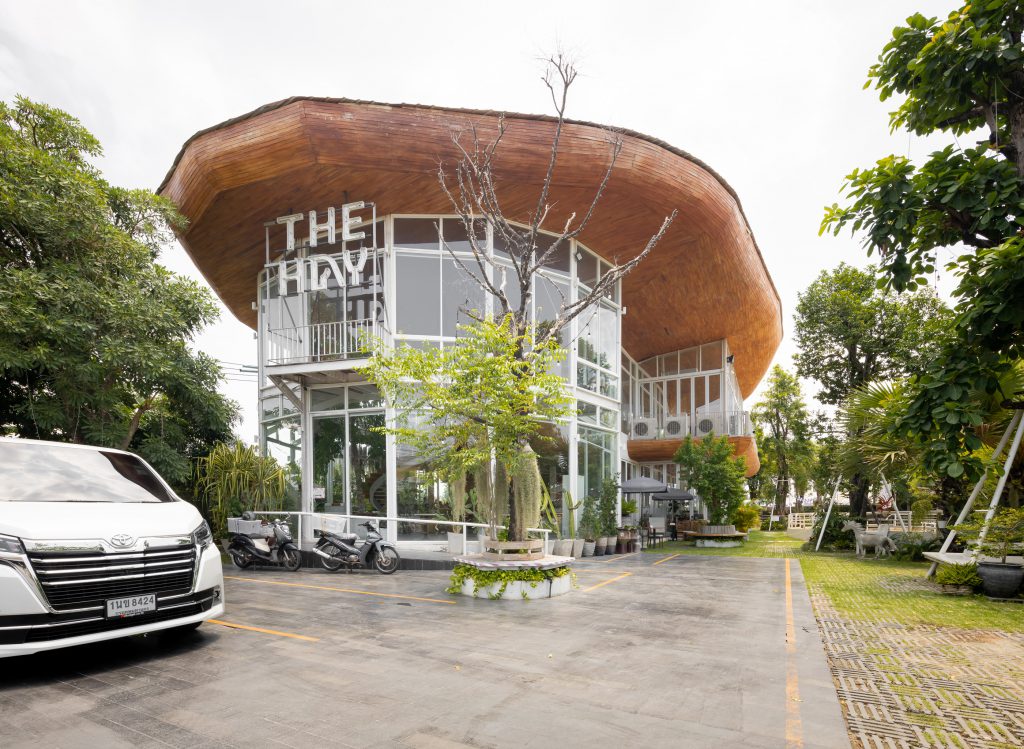
Photo: Ketsiree Wongwan
จากการที่เป็นม้าเชื่องพอในซอยเอกชัย 131 เป็นที่ตั้งของ The Hay Equestrian Center & Eatery โปรแกรมคือ โรงเรียนสอนขี่ม้าที่มีกิจกรรมบำบัดโดยการขี่ม้า (อาชาบำาบัด) โดยนิยามให้สถานที่แห่งนี้คือการให้ม้าช่วยคน ผ่านการรู้จักม้า มีกิจกรรมบำบัดให้กับเด็กพิเศษ เริ่มออกแบบเมื่อปี พ.ศ. 2560 และเริ่มเปิดใช้งานเมื่อปี พ.ศ. 2562 ตัวเจ้าของโครงการเป็นผู้ที่มีความเข้าใจลักษณะนิสัยของม้ามาก และทางครอบครัวมีความรู้ทางด้านการทำภัตตาคาร จากความรู้สองด้านที่ครอบครัวนี้ มีเป็นต้นทุนนำมาสู่การรวมกันของโรงเรียนสอนขี่ม้าและภัตตาคาร จนเกิดเป็นโปรแกรม นี้ขึ้นมา “นิยามคำว่า therapy เราไม่ได้มองว่าม้าต้องมาบำบัดคนแต่ในมุมมองทางเรา คนก็สามารถบำบัดม้าได้เหมือนกัน เรามองว่า therapy มันทำให้คนกับม้ามีปฏิสัมพันธ์กันในทางที่ดีขึ้น ซึ่งเรายึดคีย์เวิร์ดตัวนี้แล้วนำมาสู่สถาปัตยกรรม ซึ่งเรามองว่าทางทีมสถาปนิกเข้าใจปรัชญาตรงนี้ แล้วตีโจทย์ได้แตกฉานพยายามออกแบบให้คนและม้ามีปฏิสัมพันธ์กัน” บุณยวัฒน์ อดุลสิริพงศ์ เจ้าของโครงการ The Hay Equestrian Center & Eater ได้เล่าถึงที่มาของงานนี้ Architectkidd คือทีมสถาปนิกที่ได้รับเลือกให้มาตีความการบำบัด สู่การออกแบบสถาปัตยกรรม บนพื้นที่ 4 ไร่ ในซอยเอกชัย 131 เขตบางบอน ในบริบทที่เป็นชานเมืองของกรุงเทพมหานคร การออกแบบเริ่มต้นจากการค้นคว้าเกี่ยวกับม้า เพื่อเป็นข้อมูลให้สถาปนิกได้เรียนรู้ถึงลักษณะ นิสัยของม้าแต่ละตัวแต่ละสายพันธุ์ที่มีความแตกต่างกัน
ภายในบริเวณร้านอาหาร ซึ่งใช้งานไม้ที่ฝ้าเพดานเป็นพื้นที่ขนาดใหญ
Photo: Ketsiree Wongwanภายในบริเวณร้านอาหาร ซึ่งใช้งานไม้ที่ฝ้าเพดานเป็นพื้นที่ขนาดใหญ
Photo: Ketsiree Wongwan
การเข้าถึงโครงการจะเริ่มต้นเมื่อเดินผ่านส่วนจอดรถเพื่อเดินผ่านสนามฝึกขี่ม้าสองแบบทั้งสนามลู่วิ่ง และ Pony Court ผังโครงการถูกออกแบบเป็น 2 ส่วนหลักบนที่ดินรูปสามเหลี่ยมส่วนที่เป็นพื้นที่ของม้าอยู่ด้านหน้าโครงการ และส่วนสนับสนุนของโครงการคือภัตตาคารที่ตั้งอยู่ด้านหลังพื้นที่หลักของม้าคือสนามทั้ง 3 แบบ ประกอบไปด้วย สนามลู่วิ่ง และสนามขี่ม้าแบบตีวง และ Pony Court โจทย์ที่สถาปนิกรับมาเป็นการทำความเข้าใจพฤติกรรมม้า เนื่องจากม้ามีนิสัยที่ขี้กลัว ตื่นตกใจง่าย การเข้าหาม้าจึงต้องทำด้วยความนิ่มนวล สิ่งที่สถาปนิกเลือกมาเป็นเครื่องมือช่วยคือกำแพง ทำหน้าที่เป็นตัวสร้างการลำดับขั้นตอนการสร้างกำแพงทึบ สูง 2.20 เมตร จากทางเข้าและลดความสูงลงเมื่อเข้าไปยังข้างสนามขี่ม้าทั้ง Pony Court และสนามลู่วิ่ง กำแพงเหล่านี้ช่วยบังสายตาจากภายนอกได้ไปพร้อมกับช่วยเรื่องขนาดส่วนให้สัมพันธ์กันระหว่างคนกับม้าได้มีจังหวะแบบค่อยเป็นค่อยไป จากกำแพงสูงที่สถาปนิกใช้ให้เป็นตัวกั้นความวุ่นวายภายนอกสู่กำแพงกึ่งทึบกึ่งโปร่ง เมื่อเข้ามายังภายในโครงการกลายเป็นการแบ่งพื้นที่ของคนกับม้าด้วยราวกั้นจากนั้นมีส่วนกั้น คือที่นั่งความสูง 0.50 เมตร เป็นจุดที่เชื่อมโยงของสัดส่วนคนและม้าพันธุ์เล็กก่อนที่จะเชื่อมโยงทั้งคนและม้าที่สนาม จากกำแพง บริเวณทางเข้าสู่ด้านหน้าส่วนภัตตาคารกำแพงเหล่านี้มีทั้งแบบสูง เตี้ย กึ่งทึบกึ่งโปร่ง ปิดบังและเผยทั้งคน และม้า การสร้างขนาดส่วนที่สัมพันธ์ของคนและม้าผ่านการ therapy สำหรับเด็กที่เพิ่งเคยพบม้า ยังไม่กล้าที่จะลองเรียนรู้การปฏิสัมพันธ์ด้วย การขี่สามารถที่จะสร้างปฏิสัมพันธ์ด้วยการให้อาหารกับม้าพันธุ์เล็กและการสร้างเสริมทักษะ บุคลิกภาพ สมาธิ จากการขี่ม้า การออกแบบให้พื้นที่ของครอบครัวที่สามารถมองเข้ามาจากส่วนบริการให้เกิดความเชื่อมโยงกันในครอบครัว สรุปออกมาเป็นลำดับของกำแพงกับสเกลไว้ตามลำดับนี้ Solid Wall, Ventilation Wall, Railing, Seating และ Landscape
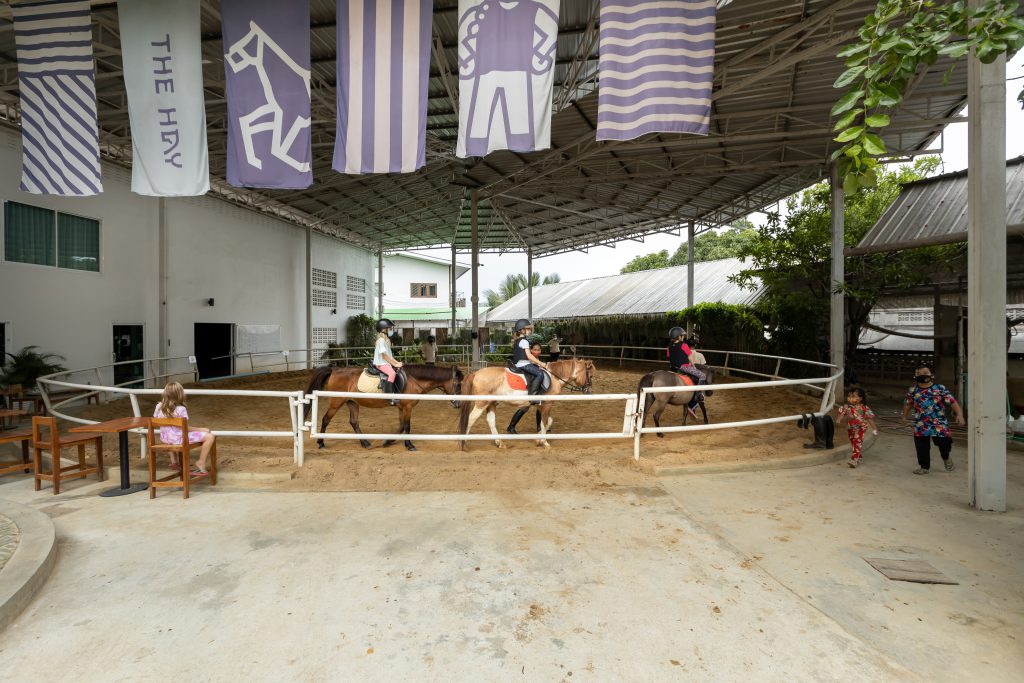
Photo: Ketsiree Wongwan
“เมื่อเราเข้าไปยังที่ตั้งที่มีคอกม้าอยู่ก่อนแล้ว ทำให้เราได้เห็นปฏิสัมพันธ์ของคนกับม้า… มันมีเค้าโครงของแนวการเคลื่อนไหวตามธรรมชาติของม้าและกิจกรรมอยู่ในพื้นที่แล้วเราก็เอาเค้าโครงเหล่านั้นเข้ามาประกอบศึกษาปริมาตรของที่ว่าง ซึ่งเราจะใช้ปริมาตรด้านข้างในการสร้าง “พื้นที่กันชน” (buffer) ในการแทรกกิจกรรมของคนกับม้าจะสังเกตได้ว่าภาษาสถาปัตยกรรมคือกำแพงนี้เอง” จริยาวดี เลขะวัฒนะ Principal Architect ของ Architectkidd ได้บอกกับเราถึงแนวคิดในการออกแบบ
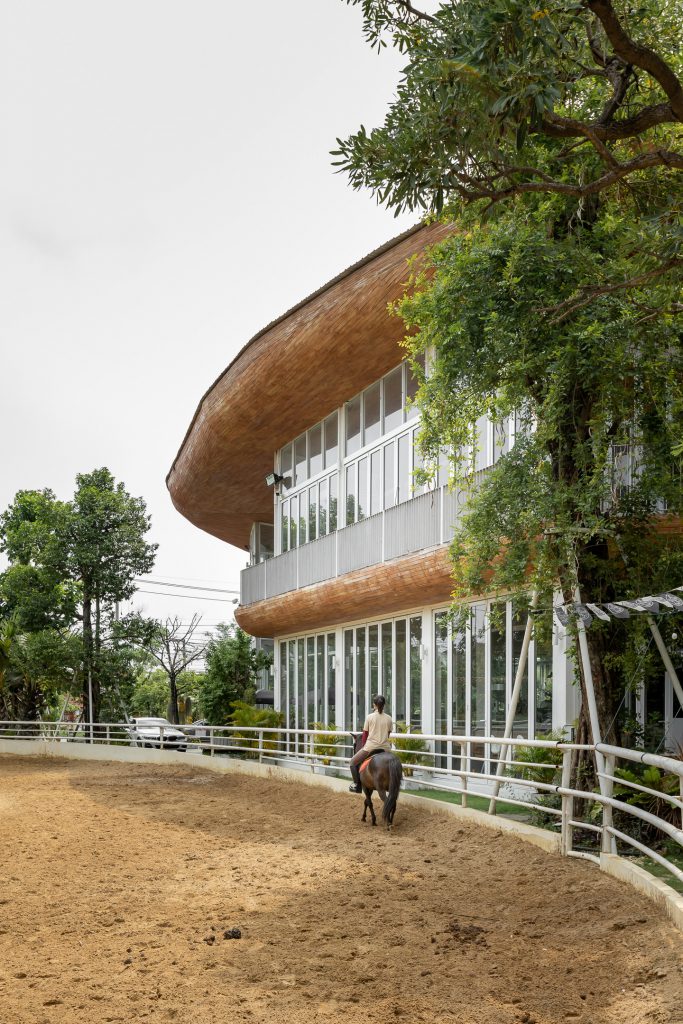
Photo: Ketsiree Wongwan
ส่วนที่ติดกับสนามของม้าเป็นกระจกสูงเปิดโล่ง เข้าหาสนามเปิดที่ว่างภายในเข้าหาภายนอกให้ครอบครัวที่มากับผู้บำบัดได้มีความเชื่อมโยงกัน จุดน่าสนใจของพื้นที่ส่วนนี้คือการออกแบบสถาปัตยกรรมจากการขึ้นรูปทรงที่มุ่งเข้าหา Organic Form จากโครงสร้างร่างกาย ม้า พื้นผิวไม้สีน้ำตาลชวนให้นึกถึงเส้นโค้งของตัวม้าสีน้ำตาลผิวสร้างจากการกรุด้วยไม้ประดู่ขนาดหน้ากว้าง 10 เซนติเมตร และหน้ากว้าง 5 เซนติเมตร ในส่วนดัดโค้งให้ง่ายต่อการดัด ทำสีด้วยเทคนิคทำสีเคลือบไม้แบบ ด้านสถาปนิกใช้การสร้างรูปทรงที่มีพื้นผิวเชื่อมเข้าหากันด้วยวัสดุที่มีเอกลักษณ์จากไม้ที่มีสีไม่สม่ำเสมอ กรุจากพื้น ผนัง ไปยังฝ้าเพดาน แล้วไหลกลับ มาที่พื้นอีกครั้งแบบ Organic Form ลดความ แข็งของรูปทรงอาคารที่เป็นสี่เหลี่ยมผืนผ้า ด้วยการรวมกับเปลือกที่เป็นไม้ให้หลอมรวมกันได้ ก่อพงศ์ เสน่หา สถาปนิกจาก Architectkidd บอกถึงที่มาของรูปทรงกับม้าว่า “การคราฟท์ ไม้ ไม่ได้อยากให้ตัวไม้มันหายไปเลย สิ่งที่เน้นจะเป็นเพดานและผนังโดยการสร้างส่วนเว้าส่วนโค้งเข้ากับสเปซที่เป็นกริด ซึ่งจะทำให้พื้นที่ ที่คราฟท์ไม้นี้แสดงออกถึงสรีระของม้าให้กลายเป็นจุดที่คนเข้ามาใช้ได้เห็นถึงเพดาน หลังคา ด้านบนจนถึงผนังชั้นหนึ่งอยากให้ตรงนี้มันชัด ให้รู้สึกถึงลักษณะของตัวม้า ขนม้า” จากรายละเอียดการออกแบบทั้งหมดนี้อาจพูดได้ว่า ในโครงการ The Hay Equestrian Center and Eatery สถาปัตยกรรมได้ช่วยทำาหน้าที่ในการบำบัดที่คนเรียนรู้จากม้าและม้าเรียนรู้จักคนที่บำบัดร่วมกัน
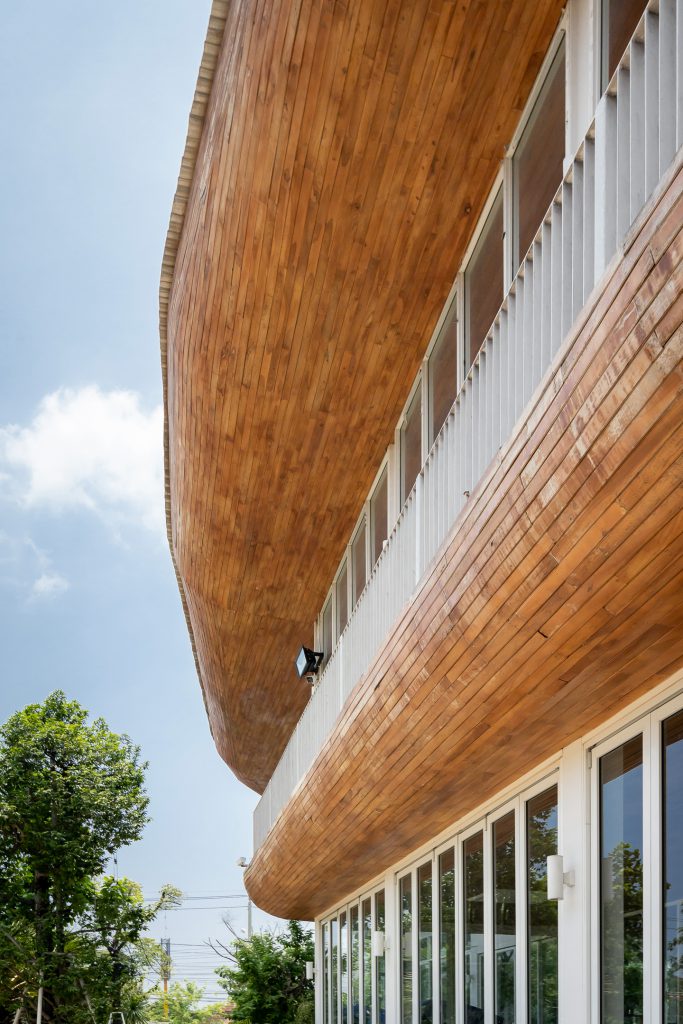
Photo: Ketsiree Wongwan
The definition of the word ‘therapy’ to us isn’t about using horses to heal people. We think of the therapy as a two-way beneficial exchange. People can also help horses heal.
Healing architecture doesn’t exclusively refer to hospitals. The definition of this particular genre of architecture now encompasses various types of built structures designed to accommodate new and different activities. One of the approaches known as Equine-assisted therapy uses horses to help with the treatments, allowing patients to participate in a range of activities that incorporate horses and other equines into the therapeutic processes designed to help improve people’s physical and mental health. Such an approach to healing chronic, incurable diseases has been practiced since the time of the Ancient Greeks. It appeared in the writings of a pioneering Greek medical practitioner and the father of medicine, Hippocrates. Equestrian therapy was widely popular among the Scandinavian countries during the spread of Poliomyelitis in 1946. Originating in Europe, this therapy method made its way to the United States in 1969 and has been practiced until today. Theoretically, horseback riding helps a patient learn to maintain their physical balance, resulting in muscle strengthening and the ability to walk. The horses chosen to help with each activity are trained and tame enough to assist the therapy.
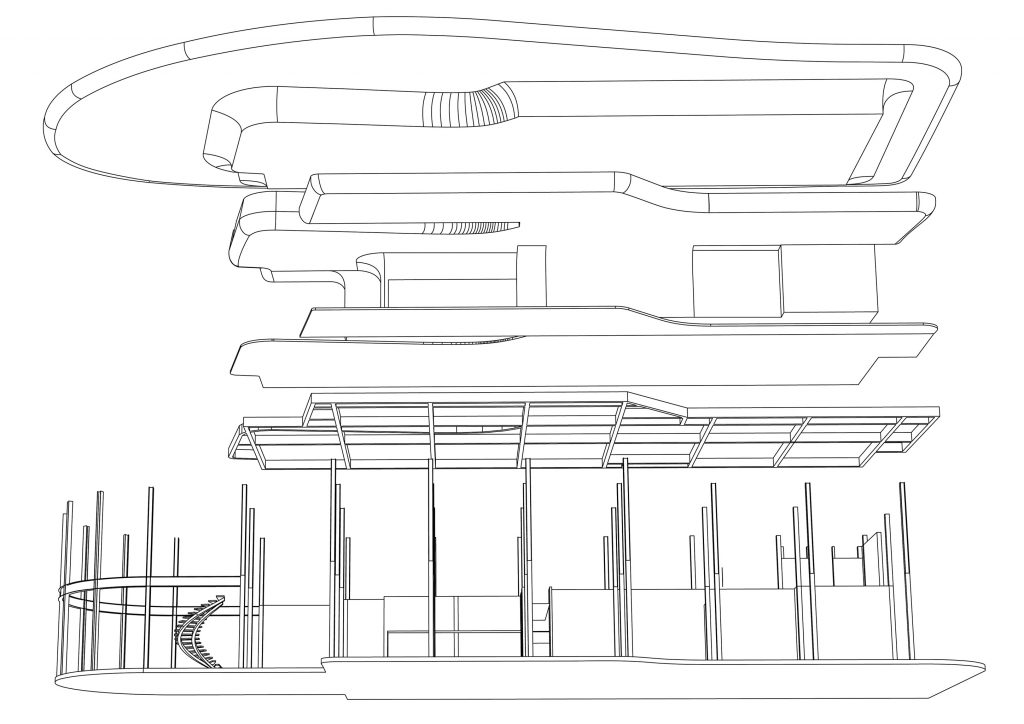
Photo: Architectkidd
The Hay Equestrian Center and Eatery are situated on Soi Ekachai 131 street. The facility offers many programs, including horseback riding classes and equine-assisted therapy as well as therapeutic activities designed for children with special needs. The center defines itself as a place where horses provide primary assistance in the treatments, and ultimately these encounters and experiences with the animals can help improve people’s physical and mental conditions. The design process began in 2017 before the construction was completed in 2019. The owner of the project combined his love and understanding of horses’ personalities with the family’s know-how in the restaurant business, giving birth to an establishment with the mixed functionalities of an equestrian center and an eatery.

Photo: Architectkidd
“The definition of the word ‘therapy’ to us isn’t about using horses to heal people. We think of the therapy as a two-way beneficial exchange. People can also help horses heal. The therapy allows humans and horses to interact more positively and beneficially. That becomes the keyword of how the architectural design is developed. The architect truly understands our philosophy and translates it into such a brilliant and clear interpretation because they tried to create a design that encourages people and horses to interact.” explained Boonyawat Adulsiriphong, the owner of The Hay Equestrian Center & Eatery, regarding the genesis of the project.
Architectkidd materialized the philosophy of equestrian therapy into the architectural design of the project, which stands on the 1.58-acre land on Soi Ekachai 131 street in Bangbon, a suburban area towards the west of Bangkok. The design process began with research conducted on the varying characteristics and personalities of different breeds of horses.
บันไดเวียนขึ้นสู่ชั้นบน ของอาคาร เห็นระเบียง และองค์ประกอบตกแต่งที่มีลักษณะของคราฟท์ และธรรมชาต
Photo: Ketsiree Wongwanผนังโดยรอบอาคาร เป็นกระจกใส สามารถมองเห็นกิจกรรมภายนอกอาคาร
Photo: Ketsiree Wongwan
The design emphasizes the ceiling and walls. By creating the concave and curved parts to the space made up of girds, the details of the crafted wood express the physical attributes of horses
To access the establishment, one has to walk past the parking area, two riding facilities, a track, and a pony court. The brief the architect needed to work with was to understand the equines’ behaviors. Since horses are jumpy and easily excited, approaching the animal requires gentleness. Walls are the architectural element the design team uses to build a hierarchy of access. The rigid, 2.2-meter- tall walls at the entrance gradually become shorter as one approaches the riding track and pony court. The walls keep the property visually obstructed from the outside while adjusting the scale be- tween humans and horses in a gradual rhythmic transition. The towering walls keep the property from being visually accessible from the outside as the rigidity lessens into the semi-airy walls as one reaches a different part of the project. The transition continues with the fences that separate people from animals. Another form of partitioning appears in the form of a 0.50-meter high seating that links humans and miniature breed horses before reconciling into full spatial connectivity at the restaurant’s front. The design uses different types of walls, from tall, short, to semi-airy walls, to separate humans and horses with varying levels of obstruction. The scales also factor humans’ and horses’ physical proportions, enabling children who are unfamiliar with equine-assisted therapy to get used to the animals while gradually learning to interact with horses through horseback riding. Children can acclimate to their interactions with the horses by feeding the miniature horses before developing their skills, personalities, and meditative abilities through horse riding.

Photo: Architectkidd
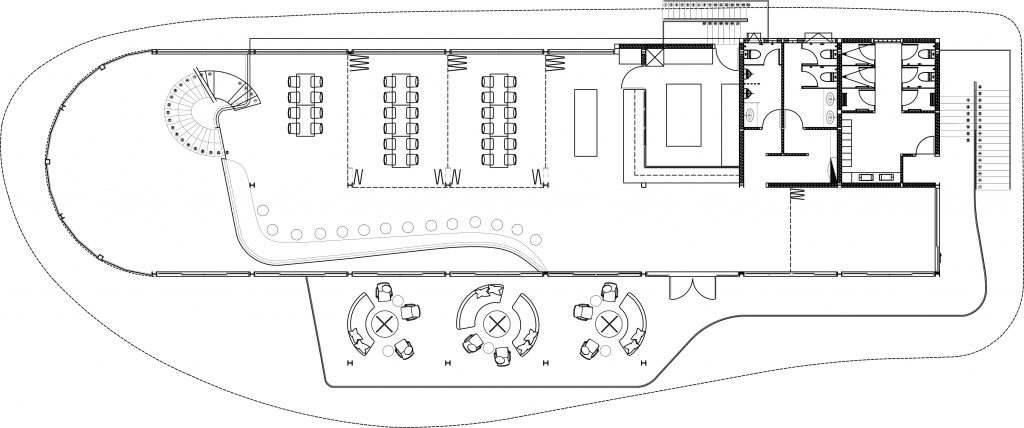
Photo: Architectkidd
The design also provides waiting areas for family members to have visual access to the activities happening at the tracks. It facilitates optical connectivity with a hierarchy of the walls of different scales and levels of density, from Solid Wall, Ventilation Wall, Railing, Seating, and Landscape.
ทางเดินจากบริเวณ ที่จอดรถไปยังตัวอาคาร
Photo: Ketsiree Wongwanมุมมองจากสนามตีวงเห็นส่วนของอาคาร ซึ่งถูกออกแบบให้กลมกลืนไป กับม้าและธรรมชาติ
Photo: Ketsiree Wongwan
“When entering the part of the location where the stables are situated, visitors can see interactions between people and animals. The design integrates the horses’ natural movements and activities as a part of the program. We studied the horses’ natural gaits and behaviors, then looked into the volume of the space. We used the rear volume to create the buffer space, where the activities and interactions between humans and horses occur. You can see that the essence of the architectural language lies in these walls,” Jariyawadee Lekawatana, Principal Architect of Architectkidd told us about the design concept.
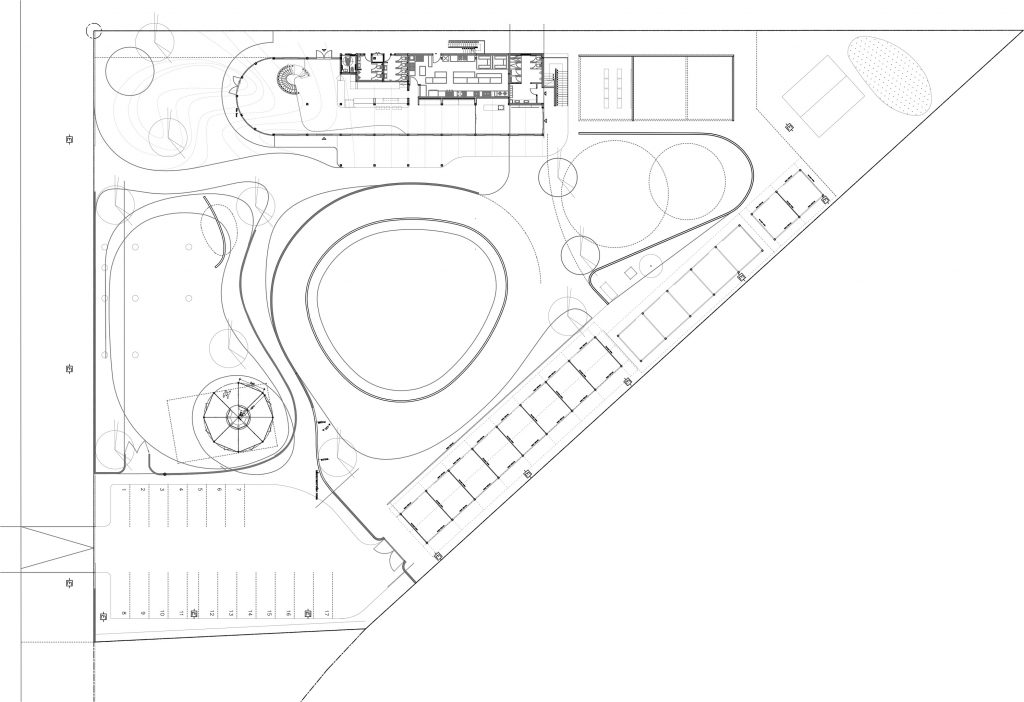
Photo: Architectkidd
The area adjacent to the tracks and pony court is partitioned with a tall, transparent glass wall, opening the interior space to the activity ground. The wall’s transparency links the interiors to the exterior space and allows the participants’ family members to observe the sessions. The intriguing part of the area is the design, whose details derive from a horse’s physical attributes, particularly the pattern of brown wood that reminds one of the curves and silhouette of a brown horse’s physique. The surface finish is made of 10-cm. and 5-cm.-wide Burma padauk wood boards with the smaller slices used to build the curved parts into a dynamic, decorative body. Matte in the finish, wooden boards of uneven colors fuse into one unified mass, covering the floor, walls, and ceiling before flowing back to the floor, creating an organic form that lessens the rigidity of the rectangular building with the convergence of wooden textures.
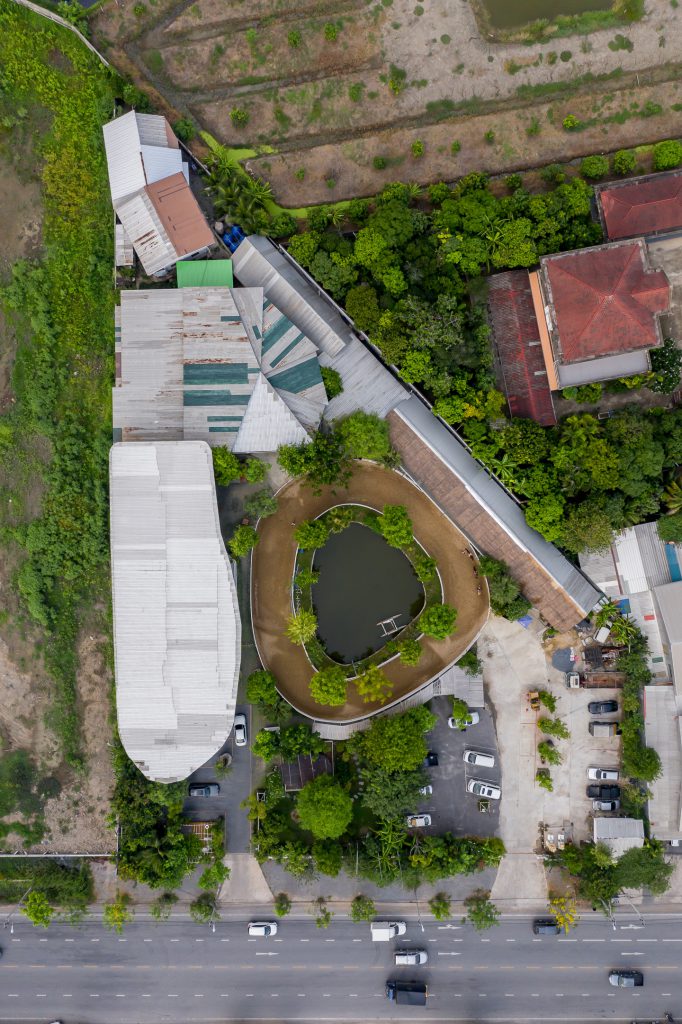
Photo: Ketsiree Wongwan
Korpong Sanaha, another member of the design team from Architectkidd, explained the origin of the architectural form and its connection with horses. “The wood is crafted in the way that the essential element of wood is still present. The design emphasizes the ceiling and walls. By creating the concave and curved parts to the space made up of girds, the details of the crafted wood express the physical attributes of horses. It’s the part of the program where visitors can walk in and see the entirety of the wooden mass, from the ceiling to the roof and the first floor’s walls. We want to accentuate that and make the horse-inspired attributes more visible for users’ experience.” With all the details of the design, the architecture of The Hay Equestrian Center and Eatery does its job at being part of the therapy as a space that encourages and nurtures people to learn from beautiful animals, and vice versa.


